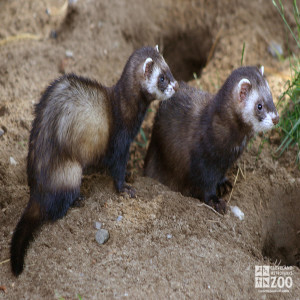Domestic Ferret
[Mustela putorius]

The head and body length of the domestic ferret varies from 8 inches to 18 inches with a tail length from 3 inches to 5.5 inches and a weight of about 60 ounces. Males are larger than females, but females have longer tails than males. General coloration is dark brown to black, with the underfur being pale yellow, and clearly seen through the guard hairs. The area between the eye and the ear is silvery white.
Location: Animals Formerly at Zoo
Share:
Range
The range of the domestic ferret is from Western Europe to the Ural Mountains.
Habitat
Domestic ferrets can be found in open forests and meadows.
Conservation Status
Least ConcernPrimary Threats
Gestation
Gestation takes approximately 42 days.
Litter
Litters can have from 2 to 12 but are usually 3 to 7.
Behavior
The Domestic Ferret also known as the European Polecat is most common in open forests and meadows. It dens in such places as crevices, hollow logs, and burrows made by other animals. It sometimes enters settled areas and building occupied by people. It is nocturnal and terrestrial, but is capable of climbing. It is usually solitary and silent, but has a variety of squeals, screams and other sounds.
Reproduction
Mating for domestic ferrets occurs from March to June, heat lasts for 3 to 5 days, and the gestation period is about 42 days. The young weigh .3 to .35 ounces at birth, open their eyes and are weaned after about 1 month, and become independent at around 3 months. Sexual maturity may come in the first or second year of life.
Wild Diet
Small mammals, birds, frogs, fish & invertebrates
